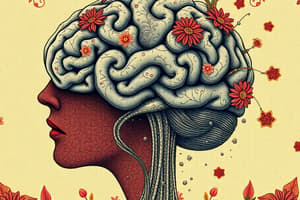Podcast
Questions and Answers
What was the primary finding of Tim Crow and Eve Johnstone's 1976 brain scanning study of individuals with schizophrenia?
What was the primary finding of Tim Crow and Eve Johnstone's 1976 brain scanning study of individuals with schizophrenia?
- Increased cortical thickness compared to the normal population.
- No discernible differences in brain structure compared to healthy individuals.
- Larger fluid-filled spaces in the center of the brain and less cortex. (correct)
- Smaller fluid-filled spaces in the center of the brain.
Initially, schizophrenia was thought to be a degenerative condition similar to:
Initially, schizophrenia was thought to be a degenerative condition similar to:
- Alzheimer's disease (correct)
- Multiple sclerosis
- Huntington's disease
- Parkinson's disease
What critical question did researchers like Sean Lewis and Danny Weinberger pose regarding schizophrenia?
What critical question did researchers like Sean Lewis and Danny Weinberger pose regarding schizophrenia?
- Does schizophrenia primarily affect cognitive functions, leaving emotional responses intact?
- Is schizophrenia solely a result of genetic predispositions?
- Can schizophrenia be entirely prevented with early intervention?
- Is schizophrenia a neurodevelopmental disorder rather than degenerative? (correct)
What was the eventual outcome of the debate between the 'developmentalists' and those who believed in the 'Kraepelinian deterioration' model of schizophrenia?
What was the eventual outcome of the debate between the 'developmentalists' and those who believed in the 'Kraepelinian deterioration' model of schizophrenia?
What discovery challenged the notion of intrinsic degeneration as the sole cause of brain changes in schizophrenia?
What discovery challenged the notion of intrinsic degeneration as the sole cause of brain changes in schizophrenia?
Jeff Lieberman's research suggested that, regarding the effects of antipsychotics on brain structure, which of the following is most accurate?
Jeff Lieberman's research suggested that, regarding the effects of antipsychotics on brain structure, which of the following is most accurate?
What was the alternative explanation for brain structure changes that were initially attributed to schizophrenia itself?
What was the alternative explanation for brain structure changes that were initially attributed to schizophrenia itself?
The study by Nancy Andreasen, focusing on long-term patient follow-up, related the amount of antipsychotic medication to changes in what?
The study by Nancy Andreasen, focusing on long-term patient follow-up, related the amount of antipsychotic medication to changes in what?
Which of the following describes the insight gained from studies involving animals given antipsychotics?
Which of the following describes the insight gained from studies involving animals given antipsychotics?
Aside from medication effects, which of the following lifestyle factors contributes most significantly to changes in brain structure among individuals with psychosis?
Aside from medication effects, which of the following lifestyle factors contributes most significantly to changes in brain structure among individuals with psychosis?
Why might improvements be expected if an individual with psychosis decreases their dose of antipsychotics, stops taking cannabis, or loses weight?
Why might improvements be expected if an individual with psychosis decreases their dose of antipsychotics, stops taking cannabis, or loses weight?
What led to the resurgence of the 'pessimistic Kraepelinian view' in 2005 regarding schizophrenia?
What led to the resurgence of the 'pessimistic Kraepelinian view' in 2005 regarding schizophrenia?
According to the information presented, what is the potential impact of chronic stress (resulting in elevated blood cortisol) on the brain?
According to the information presented, what is the potential impact of chronic stress (resulting in elevated blood cortisol) on the brain?
Which statement best captures how modern understanding has shifted the view of brain changes formerly attributed to intrinsic degeneration in schizophrenia?
Which statement best captures how modern understanding has shifted the view of brain changes formerly attributed to intrinsic degeneration in schizophrenia?
What was the initial interpretation of the changes visible in the brain scans of people with schizophrenia?
What was the initial interpretation of the changes visible in the brain scans of people with schizophrenia?
How did researchers solve the argument over whether the decline in cortical volume was due to the illness itself, or the anti-psychotics?
How did researchers solve the argument over whether the decline in cortical volume was due to the illness itself, or the anti-psychotics?
Which of the following is the closest meaning of the original Kraepelinian term for schizophrenia, 'dementia praecox'?
Which of the following is the closest meaning of the original Kraepelinian term for schizophrenia, 'dementia praecox'?
Which action would directly not create improvements for someone with psychosis?
Which action would directly not create improvements for someone with psychosis?
During the period in which psychosis patients were given the drug Haloperidol, what was discovered compared to those who took Olanzapine?
During the period in which psychosis patients were given the drug Haloperidol, what was discovered compared to those who took Olanzapine?
What was the average does of Chlorpromazine patients were being given?
What was the average does of Chlorpromazine patients were being given?
Flashcards
Dementia Praecox
Dementia Praecox
The original term for schizophrenia, meaning premature dementia.
Brain Scans of Schizophrenic Patients (1976)
Brain Scans of Schizophrenic Patients (1976)
Larger fluid-filled spaces and less cortex compared to normal population, with cognitive difficulties.
Neurodevelopmental Hypothesis (Schizophrenia)
Neurodevelopmental Hypothesis (Schizophrenia)
The idea that schizophrenia involves abnormal brain development from early in life.
Kraepelinian Deterioration
Kraepelinian Deterioration
Signup and view all the flashcards
Haloperidol
Haloperidol
Signup and view all the flashcards
Olanzapine
Olanzapine
Signup and view all the flashcards
Antipsychotic Dosage and Brain Volume
Antipsychotic Dosage and Brain Volume
Signup and view all the flashcards
Chlorpromazine
Chlorpromazine
Signup and view all the flashcards
Lifestyle's Effect on Schizophrenia
Lifestyle's Effect on Schizophrenia
Signup and view all the flashcards
Cannabis
Cannabis
Signup and view all the flashcards
Study Notes
- Modern schizophrenia research began in the mid-1970s.
- Tim Crow was the first to use brain scanning for schizophrenia.
- Dementia praecox, was the original Kraepelinian term for schizophrenia.
- In 1976, Tim Crow and Eve Johnstone discovered that schizophrenic patients have larger fluid-filled spaces in their brains.
- Schizophrenic patients also have less cortex and some cognitive difficulties.
- Initial studies focused on chronic, institutionalized schizophrenics with severe illnesses.
- Early theories suggested schizophrenia was due to brain tissue loss, akin to a "mini-Alzheimer's".
- In 1987, it was proposed that changes in schizophrenia were developmental, not degenerative.
- An article in The British Medical Journal questioned if schizophrenia was a neurodevelopmental disorder.
- It was theorized that something disrupts normal brain development, initiating schizophrenia.
- The argument between developmental and Kraepelinian (degenerative) theories lasted about 10 years.
- The developmental hypothesis became widely accepted in the late 1980s to early 2000s.
- A study in 2005 suggested a progressive notion, and rose from the grave.
- It is important to distinguish if a disorder is degenerative, which carries a gloomy outlook, compared to a developmental one.
- The 2005 study scanned first-episode psychosis patients for about a year.
- Patients on haloperidol showed a greater decline in the cortex with each scan.
- Control groups and patients on olanzapine did not show this decline.
- Jeff Lieberman and colleagues interpreted this as intrinsic brain degeneration in schizophrenics, worsened by haloperidol.
- An alternative view is that Haloperidol caused degeneration.
- Rene Kahn became convinced of a progressive brain disorder due to long-term follow-up studies.
- A 2008 study led by Nancy Andreasen found the amount of anti-psychotic medication correlated with brain changes.
- Patients receiving the equivalent of 929mg of chlorpromazine daily showed a greater decline in cortical volume.
- Those receiving a smaller dose (115mg of chlorpromazine) showed less decline.
- An argument arose about whether medication dosage or illness severity drove the cortical decline.
- Studies in monkeys and rats showed that anti-psychotics led to a decline in the volume of the cortex.
- What was initially considered progression, or intrinsic schizophrenia, may be due to antipsychotics.
- Progressive brain changes thought to be due to schizophrenia may be due to anti-psychotics.
- Cannabis and other drug use contributes to progressive brain change.
- Stress, high blood cortisol levels, lack of exercise, obesity, diabetes, and hypertension also impact brain health.
- Changes once seen as intrinsic degeneration may be related to the lifestyle of psychosis patients.
- Improvements may be seen by decreasing the dose of medication, stopping cannabis use, or losing weight.
Studying That Suits You
Use AI to generate personalized quizzes and flashcards to suit your learning preferences.




